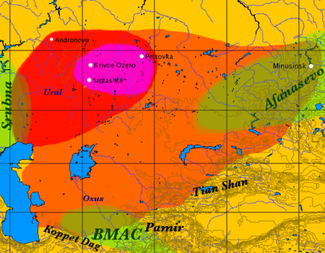Proto-Indo-Iranian religion means the religion of the Indo-Iranian peoples prior to the earliest Hindu (Indian) and Zoroastrian (Iranian) scriptures. These share a common inheritance of concepts including the universal force *rta (Sanskrit rta, Avestan asha), the sacred plant and drink *sauma (Sanskrit Soma, Avestan Haoma) and gods of social order such as *mitra (Sanskrit Mitra, Avestan and Old Persian Mithra, MiÏ'ra), *bhaga (Sanskrit Bhaga, Avestan and Old Persian Baga). Proto-Indo-Iranian religion is an archaic offshoot of Indo-European religion.
Introduction

Indo-Iranian languages include three subgroups: first Indo-Aryan languages (including the Dardic languages); second Iranian languages (east and west) and third Nuristani languages. From these various and dispersed cultures, a set of common ideas may be reconstructed from which a common, unattested proto-Indo-Iranian source may be deduced.
The Proto-Indo-Iranian religions influenced Zoroastrianism, Hinduism, Buddhism, Jainism and Manichaeism.
Beliefs developed in different ways as cultures separated and evolved. For example the cosmo-mythology of the peoples that remained on the Central Asian steppes and the Iranian plateau is to a great degree unlike that of the Indians, focused more on groups of deities (*daiva and *asura) and less on the divinities individually. Indians were less conservative than Iranians in their treatment of their divinities, so that some deities were conflated with others or, conversely, aspects of a single divinity developed into divinities in their own right. By the time of Zoroaster, Iranian culture had also been subject to the upheavals of the Iranian Heroic Age (late Iranian Bronze Age, 1800â€"800 BCE), an influence that the Indians were not subject to.
Sometimes certain myths developed in altogether different ways. The Rig-Vedic Sarasvati is linguistically and functionally cognate with Avestan *HaraxvaitÄ« Ä€rÉ™duuÄ« SÅ«rÄ AnÄhitÄ. In the Rig-Veda (6,61,5â€"7) she battles a serpent called Vritra, who has hoarded all of the Earth's water. In contrast, in early portions of the Avesta, Iranian *Harahvati is the world-river that flows down from the mythical central Mount Hara. But *Harahvati does no battle â€" she is blocked by an obstacle (Avestan for obstacle: vÉ™rÉ™Ï'ra) placed there by Angra Mainyu.
Cognate terms concepts

The following is a list of cognate terms concepts that may be gleaned from comparative linguistic analysis of the Rigveda and Avesta. Both collections are from the period after the proposed date of separation (ca. 2nd millennium BCE) of the Proto-Indo-Iranians into their respective Indic Iranian branches.
Relationship to Proto-Indo-European religion

When Vedic texts were the oldest surviving evidence of early Indo-European-speaking peoples, it was assumed that these texts preserved aspects of Proto-Indo-European culture with particular accuracy. Many ethnologists hoped to unify Indo-Iranian, Celtic, Norse, Greek, Germanic and Roman into a Proto-Indo-European religion. Max Müller believed that Indo-Iranian religion began as sun worship. G. Dumézil stressed the tripartite social system of Indo-European religion and society. Later scholarship has moved away from considering all these religions near-identical. Instead, since early in the 20th century, following Meillet, Thieme and Kuiper, the social function of the Indo-Iranian *Asura/Āditya deities has been stressed; they are an innovative group not found in Indo-European religion.
See also

- Religion and culture in ancient Iran
- Historical Vedic religion
- Hinduism
- Indian religions
- Zoroastrianism
- Iranian religions
- Proto-Indo-Iranians
- Persian mythology
References
